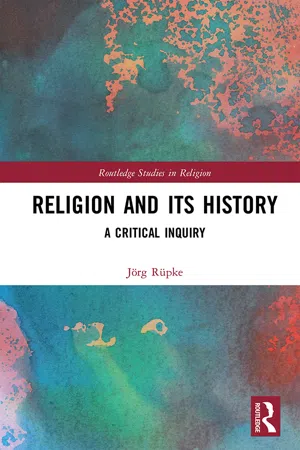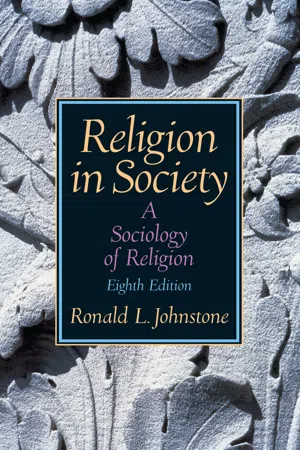History
Religious Divisions
Religious divisions refer to the conflicts and separations within a religious community, often stemming from differing beliefs, practices, or interpretations of religious texts. These divisions have historically led to schisms, sectarianism, and even religious wars, shaping the course of history and influencing political and social dynamics within societies.
Written by Perlego with AI-assistance
Related key terms
Related key terms
1 of 4
Related key terms
1 of 3
3 Key excerpts on "Religious Divisions"
- eBook - ePub
- Adrian Guelke(Author)
- 2013(Publication Date)
- Polity(Publisher)
Other examples might be given where communal divisions coincide with the presence of adherents of two of the world’s major religious faiths. Thus the divide in Cyprus might be conceived of as one pitting Greek Orthodox Christians against Muslims, the divide in Sri Lanka as pitting Buddhists against Hindus; but in both cases religion is not the primary source of the division and its role as a cause tends to be downplayed. A case where it is more difficult to dismiss the role of Religious Divisions per se is inter-communal conflict in India between Hindus and Muslims. But its episodic nature, as well as Hindu predominance in the country as a whole, has prevented this cleavage from dominating the country’s politics to the point that the vast country of India could be described as a deeply divided society in its own right. However, it is possible to describe particular regions of India, such as the state of Jammu and Kashmir, as deeply divided.Conflict also occurs between different branches of the same faith, and there are a number of places in which these sectarian differences are a source of division. The most obvious case of a society divided along sectarian lines is Northern Ireland. Yet even though the conflict has been most commonly, as well as accurately, described as one between Protestants and Catholics, it can be argued that, since what has divided the society has little to do with religious doctrine, religion should be seen simply as a marker of ethnic or national differences. And that is widely reflected in the literature in the characterisation of Northern Ireland as an ethnically divided (as well as a deeply divided) society. The conflict between Sunni and Shi’a Muslims in Iraq since the overthrow of Saddam Hussein is another instance of a society divided along sectarian lines, but in this case it cannot be argued that religion is a marker of different national identities. However, politics in American-occupied Iraq has not been entirely dominated by the country’s sectarian divide, not least because of the further complication of the Kurdish question. Lastly, religion has provided a source of division even in societies in which religious observance has been largely confined to a single branch of one of the major religions. In particular, in Catholic countries such as France, Spain and Italy considerable tensions have arisen from time to time between clerical and anti-clerical forces. - eBook - ePub
Religion and its History
A Critical Inquiry
- Jörg Rüpke(Author)
- 2021(Publication Date)
- Routledge(Publisher)
1 Religious individualization and a critical view of the concept of religionLooking at religion
Religious Studies is a flourishing subject area in many academic cultures, as well as in the world beyond the university. Religion was clearly an important force in past societies, leaving its mark on almost all aspects of personal and collective life, from social and physical ‘heritage’ to the proliferation of battlefields marked out in wars fought over doctrine. Religious practices are widely visible even in today’s megacities. Religious identities are ever more frequently and forcefully used and ascribed in diverse and pluralistic societies to both individuals and collectives. Religious institutions are prominent as powerful non-governmental organizations and agents in international affairs. Religious agents are closely related to policy-makers and play influential roles behind the scenes, as well as on the public political stage, in a growing number of states across the globe. Religious agents, practices, and ideas are quickly adapting to a changing world. Understandably, then, the dynamics of religion have come to the fore in recent global research (Bochinger and Rüpke 2016 ).Yet can we really use the term ‘religion’ as if religion is simply ‘out there’? As is the case with most concepts – and in particular concepts that define academic disciplines, including ‘history’ – ‘religion’ has a conceptual lineage that is characterized by historical contexts and biases. The very differentiation of religion and the secular, of religion and non-religion, is, without a doubt, a historical product and the outcome of specific interests enacted by specific historical agents.1 The making of such differences has been used as a tool in a variety of ways. For instance, political agents, in particular from the end of the 18th century ce onwards (Conrad 2016 ), have used this kind of differentiation in order to exclude people from decisions now reserved for ‘politicians’ or the ‘state’, while religious actors have sought to elevate people above criticism and protect property from the vagaries of commercial forces, as is attested as early as the first millennium bce . (Historiography was far from being the least significant way of enacting such differences, as we will see later). Yet why should we want the discipline to restrict itself to the study of certain early modern and modern discourses (and to the practices related to those discourses) in the few languages that employ the term religion? And why would we want to theorize about such practices of classification (thus McCutcheon 2012 , 88; productively applied by Klippenstein 2012 , for example)? The answer is that the many different concepts of religion used in research do yield results, do identify or regroup evidence that would otherwise be lost in a myriad of undifferentiated cultural practices. The same holds true if we systematize and apply concepts such as dharma, sampradaya , or shūkyō (to name just a few from South and East Asia), at least so long as we do not treat them simply as synonyms of religion and instead use them to provide new perspectives on data included or excluded by this particular concept. But systematically enlarging our range of concepts beyond a few European languages (or just English) as a source of concepts is still far from a globally accepted practice. People do change objects – literally, stuff – by including them in specific practices, and such materialities (religious, from one perspective at least) change people (Berg 2019 ; Chidester 2018 ; Droogan 2013 ; Karstein and Schmidt-Lux 2017 ; Löw 2016 ; Morgan 2010 ; Promey 2014 ). Even critics of the concept do implicitly, or even explicitly, rely on the notions of religion or religious in their own work (see Stausberg 2013 - eBook - ePub
Religion in Society
A Sociology of Religion
- Ronald Johnstone(Author)
- 2015(Publication Date)
- Routledge(Publisher)
But another important type of religious conflict is what we call intrareligious conflict, which is defined as conflict within the religious group. Introduction At an initial and superficial level of thought, one might not expect to see much of this. People who join together in a religious group to worship God agree with one another. As such, they would certainly not be in conflict. Yet if we take the sociological perspective and our knowledge of social functioning at all seriously, we would actually expect less than perfect consensus from the very beginning, because religious groups are in many ways like all groups (see Chapter 1). They always have subgroups with special interests; local subunits (congregations) are exposed to different stimuli and influences, exist in a unique social environment and, therefore, evolve somewhat differently from other subunits. This occurs, despite the fact that they all formally subscribe to the same creed. Such conflict within a religious group can become extremely significant and emotionally consuming, because in the minds of the participants, the issues are often perceived as having life-and-death eternal significance. This is basically what the Reformation and, later the Counter-Reformation, were all about. If right belief and right behavior are necessary for eternal salvation, then differing interpretations of right belief and right behavior become crucial. And so doctrinal controversies have been nearly perpetual in most religions. As we saw in the last chapter, conflict over correct interpretations of a group’s sacred writings can result in sectarian withdrawal of one or more subgroups from the parent group. Such ruptures and splits can be seen in all major religions—Christianity, Islam, Hinduism, and Judaism, to name the best known
Index pages curate the most relevant extracts from our library of academic textbooks. They’ve been created using an in-house natural language model (NLM), each adding context and meaning to key research topics.
Explore more topic indexes
Explore more topic indexes
1 of 6
Explore more topic indexes
1 of 4


